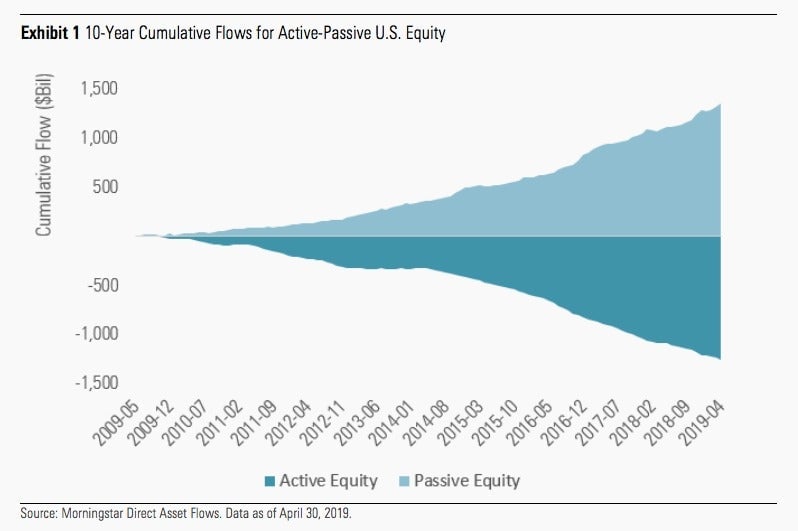Half of US stock fund assets are now invested in index funds
It’s (almost) official: Passive funds have just about reached parity with actively managed ones in the US stock market. “This is a milestone that has been a long time coming,” Kevin McDevitt, a senior analyst at Morningstar said in a statement. “The trend toward low-cost fund investing has gained momentum.”


It’s (almost) official: Passive funds have just about reached parity with actively managed ones in the US stock market. “This is a milestone that has been a long time coming,” Kevin McDevitt, a senior analyst at Morningstar said in a statement. “The trend toward low-cost fund investing has gained momentum.”
Investors have put $4.305 trillion into passive US stock market funds as of April 30, only $6 billion shy of the $4.311 trillion overseen by active US equity funds, according to a Morningstar report. This month’s data will very likely show that the passive funds have surpassed those that are actively managed.
The shift has been going on since 2006, with money flowing out of active and into passive every year since then. It’s taking place as a growing number of investors realize that highly paid money managers are seldom able to beat broad benchmarks of stock market performance. More than $39 billion of cash went into passive US equity funds last month, compared with $22 billion for their active counterparts.

Index funds buy baskets of securities matched to a benchmark, which can be cheaper for asset managers to operate and oversee. Fees for the most basic “vanilla” passive funds, run by giants like Vanguard, BlackRock, and State Street, have been steadily drifting towards zero. Passive fund managers can still make money in multiple ways, such as by cross-selling other products to customers, including higher-fee passive funds that track an innovative index, such as so-called smart beta or factor investing products.
When it comes to passive investments, can there be too much of a good thing? A concern is that, if too much money flows into funds that simply track an index, markets will become inefficient, and prices will no longer reflect the underlying value of specific assets. It’s worth remembering that many passive funds are used actively, with investors and traders buying and selling them regularly to rebalance their portfolios. Indexes have become a way for some investors to pursue individualized strategies.
The economies of scale in the passive stock market universe also highlight how asset managers are able to charge such low fees. Companies that manage as much money as Vanguard, which oversees $3 trillion, can charge a few basis points for funds and still cover their costs. Of course, charging no fee at all is another matter. When asset managers forgo fees altogether they have to make up the lost profit somewhere else, which could complicate life for regular investors trying to understand how they’re actually paying for asset managers’ services.
(The headline of this story has been corrected to show that Morningstar data refers to US equity market funds, and not the entire US stock market.)